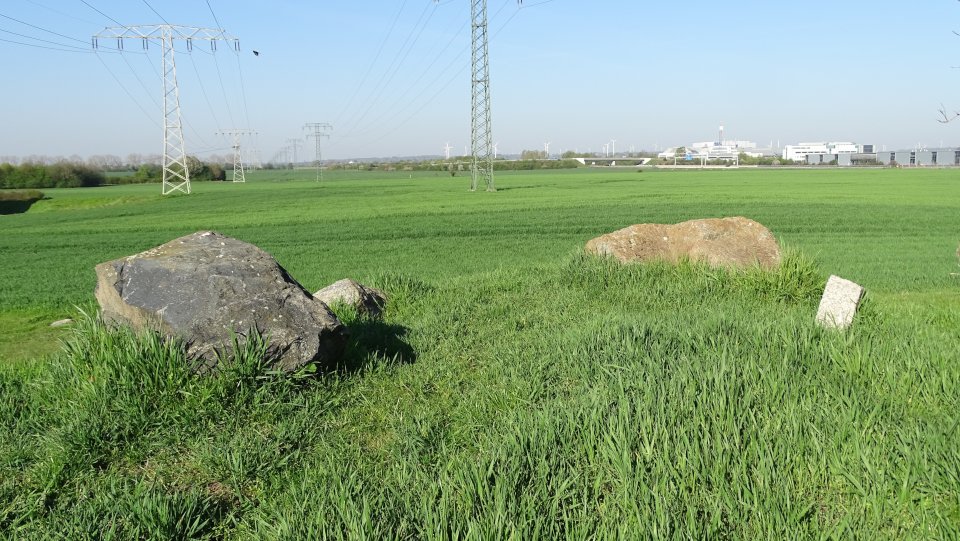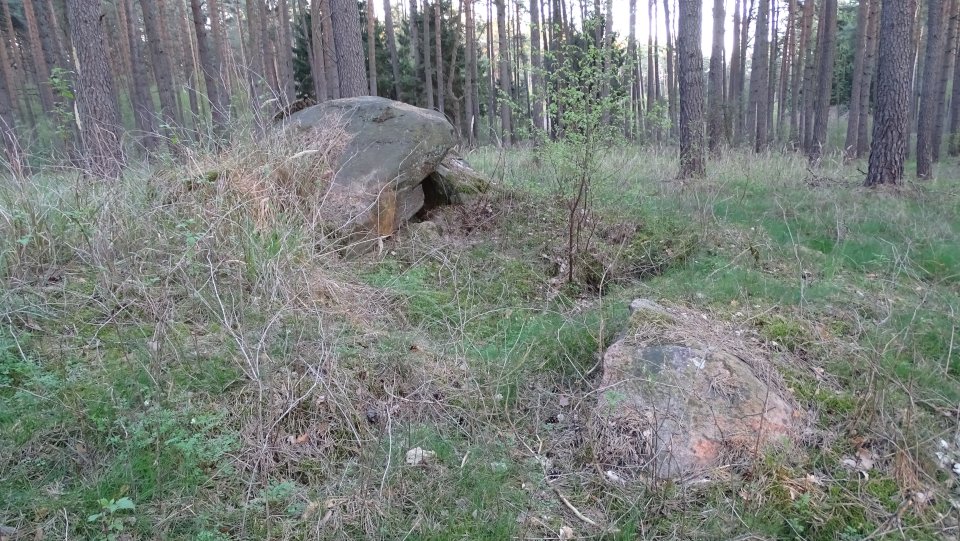





Schortewitz Passage Grave
Southernmost megalithic tomb in central Germany
Origin in the younger Stone Age about 3,200 BC.
In 1913, 11 skeletons were buried inside the burial chamber and the remains of 11 burials in the outskirts next to some amulets and shards.
Visited April 2019
Gehrden 1 belongs to the type of a chamberless Hunenbeds and represents as such the only surviving megalithic tomb of this type in Saxony-Anhalt. And wow, this northwest-southeast orientated hunebed is really of impressive size. It has a length of 51 meters and is almost completely preserved. Of the original sixty-five stones made of granite and porphyry, fifty-eight are still present. Some are missing on the northeastern long side as well as on the narrow sides. In contrast to the usual trapezoidal arrangement, they are arranged at right angles. The on site information board states that these large stones served to cover the burial chambers, this is certainly wrong. Ceramics of globular amphorae culture were found in the Hunebed.
Drive on the K1233 from Gehrden towards Lübs. Immediately before leaving the village, there is an entrance to a farm on the left side. Turn left here, park the car and walk along a track leading in a southwestern direction. The path then passes between sheep barns, pastures and a game reserve until you reach the complex after about 220 meters.
Visited April 2019









Lütnitz belongs to the type of passage graves and is oriented east-west. Three of the four stones of a former burial enclosure are still present. The only surviving capstone has been broken and dropped into the burial chamber. From the enclosure are still some stones recognizable. In the Hunebed ceramic remains of the recent Tiefstichkeramik culture were found, in the burial chamber from the Globular Amphora Culture.
Drive on the L60 from Ladeburg in the direction of Möckern. Approximately 3.2 kilometers past Ladeburg, a dirt road branches off to the left and the right, take the left one. Continue on this dirt road for about 280 m and park here at a dirt road junction. Walk straight on from here for about 150 m, the tomb lies 35 m in the field to your left under a group of trees.
Visited April 2019








Körbelitz or Hoher Stein is a dolmen with a chamber oriented in the north-east-west-southwest direction, of which only the western part is preserved. The eastern part of the chamber is not preserved, so its original length and exact type of tomb can not be determined. The northern long side has two, the southern still a supporting stone. An endstone is present, as well as a capstone. The capstone has several cups on its top. It has a circumference of 5.8 m, a length of 2 m and a width of 1.4 m. Up to 1790/99 two more enclosure should have existed.
Drive on the L52 from Körbelitz to Wörmlitz. At the end of the village, the road make a sharp left turn. 725 m after the bend, a brown sign points into a dirt road that leads to the tomb. Drive around 350 m on this track until you reach the parking lot for the tomb. Walk the remaining 200 m to this nice dolmen from here.
Visited April 2019
taken from the information board at the parking lot
The Giant Tomb
Rest of a megalithic tomb from the Stone Age
The megalithic tomb is considered the oldest testimony to the settlement of this area in the Neolithic period from 4.500 – 1.800 BC.
A large stone covers four smaller stones. Three of them are supporting the capstone.
The mound, which once surrounded the stones and covers the tomb, has long since been cleared away by wind and weather over the past centuries.
Originally the tomb was bigger. It should have continued to the east. Until 1790/99 two so-called Hunebeds should still have existed. For the construction of the tomb site, the boulders of various sizes, which were carried by the glacial glaciers from the north and subsequently deposited, were used.
This is also shown by the large stone of the war memorial 1914 – 18 in front of the church in Körbelitz, because the stone was retrieved in the immediate vicinity of the Hunebed 1921 from Schwarze acre.
The megalithic tomb was placed under protection on 1 July 1956 and has since been considered a ground monument. It is located along the communal grounds of the district Körbelitz west of the dirt road to Büden southeast of the village location.
The legend of the megalithic tomb is available from the local folklore society.
taken from Heimatheft der Gemeinde Körbelitz, 1997
From the giant lineage based in Nisselheim
At Körbelitz, two giants arrived.
They built two castles nearby,
so that they see each other quite often.
They lived in peace and unity,
Until a while ago, a giant woman entered.
Since they did not have any women yet,
Both committed themselves as spouses.
Now the cause was given to the fight,
Which should embitter their life.
Gone was the unity
Immediately the wild quarrel began
And the warriors, the brave ones,
Were very strong as a giant.
The one throws a boulder into the castle,
The other one also used such stones.
So they hurled the stones from castle to castle,
Smashed the towers, through the walls.
One of them was hit and fell down
And soon afterward struggled with death.
Then the remorse returns to the other,
With compassion, he enters the castle,
He still meets his friend alive
Give him the hand as a noble man
And promises, as the friend had told him,
The last honor to prove him.
When he gave up his spirit,
First he digs a shallow grave for him.
Then he brings huge stones,
To cover the bones of the dead.
He erects the stones to a chamber,
Put in jar and hammer,
Rest the dead in it ‘
And cover them with big stones.
The castle sites are empty and desolate,
The tomb still exists today.
And whoever makes a stop in the village,
Can still hear from this legend.









Pfahlberg is believed to be the remains of a megalithic tomb consisting of six support stones. On a round mound lies some stones or fragments. A no longer complete stone with a well-recognizable borehole represents a remainder of the chamber.
Already in historical time the tomb served for the extraction of building material. Stonecutter had crushed the large stones mainly and transported away, so that essentially debris was left behind. The tomb remained untouched for a long time. During the time of the GDR, a large housing estate was built south of the Pfahlberg. The burial mound became a popular playground. In this context, it came again to interventions in the mound. Therefore, the tomb was archaeologically examined in 1984. During the excavation, it was found that the burial chamber originally consisted of about six wall stones and inside a dimension of 2 – 3 meters long and 1 meter wide. Skeletal remains and a cup were found in the former burial chamber.
Pfahlberg is the only megalithic grave in Magdeburg in which some stones or fragments can still be seen.
Access to the remains of this tomb is located between the Pfahlberg business park and the A2 motorway (junction Magdeburg Zentrum), directly behind a large furniture store. There is also an information board.
Visited April 2019






The tomb lies about 2.4 km northwest of the village in the forest.
Immekath 1 is a grand dolmen consisting of at three pairs of supporting stones probably without an enclosure. The current state of preservation is bad, several supporting stones and capstones are missing. The existing capstone lies diagonally in the chamber. The rectangular chamber is east-west orientated, 3.7 m long and 1.6 m wide. Six wall stones and one of formerly three capstones is preserved. The capstone measures 2 m x 1.8 m x 0.8 m.
Drive from Immekath on the K1117 in the direction to Riestedt. As the road turns north, a cobblestone road heads west, just before the last houses of Immekath. This road leads to the sports field. Continue straight on, the road becomes a gravel and sand track, and after 1.4 km you reach the edge of the forest, park here. Walk. Follow the path for 200 meters and turn right, behind an older, fenced-in conservation. Follow this path in northern direction for about 350 m, passing a conservation of recent date on the left side. Shortly after this conservation, you follow a branching off to the left, which is rather overgrown, and then reaches the tomb after about 100 meters.
Visited April 2019






site plan according to Krause / Schoetensack 1893
Visited April 2019
The tomb lies about 2 km northwest of the village on a tilled field in a small depression on a western slope, without direct access.
Immekath 2 is a grand dolmen consisting of at least four pairs of supporting stones. The current state of preservation is bad, only part of the chamber is present, the mound is heavily plowed. In 1931 it is said that there were still two enclosure stones, which were missing in 1932. The chamber is northwest-southeast orientated, according to Danneil the chamber was 7.5 m long, 3.8 m wide and had four capstones. Today, only one capstone and five wall stones are present, the chamber is 6.2 m long and 1.2 m inside. The capstone measures 2.3m x 1.7 m x 0.9 m.
Drive from Immekath on the K1117 in the direction to Riestedt. As the road turns north, a cobblestone road heads west, just before the last houses of Immekath. This road leads to the sports field. Continue straight on, the road becomes a gravel and sand track, and after 1.4 km you reach the edge of the forest, park here. The tomb lies 200 meters north of the slope and 50 meters before the edge of the forest in the field. That means it is recommend to visit the site only, if the field is lying fallow.
Visited April 2019